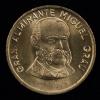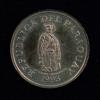EDSpanish Class
Displaying 1 - 50 of 96
| Catalog # | Name | Description | ||
|---|---|---|---|---|
| 1 | ED1997.2.9 | Mask | Wooden mask. Face with frog in the center of the forehead. In the inside written "purchased in village near Guatamala City 1948". |
 |
| 2 | ED1998.11.2 | Comb | Five metal tines with a wooden handle. This comb would be used with a guiro to create a scraping sound. Used namely in Latin American and Cuban music. |
 |
| 3 | ED1998.8.13 | Vest | Woolen poncho style cardigan, open in the front with ties. Beige with black and grey geometric design on back. |
 |
| 4 | ED1999.6.1 | Bag | Small bag (9 x 10cm) embroidered with stylized animals on the front, a geometric design on the back. Cream canvas with a red drawstring. Includes a pamphlet on the Reserva Ecologica Huitepec (Huitepec Ecological Reserve), which is located in the state of Chiapas in southern Mexico. The pamphlet and bag are made by Pronatura, which is the largest Mexican environmental conservation group. The text in the pamphlet relates the etiological myth from the Popol Vuh that explains why rabbits have long ears. The hero twins tried turning the forest of Huitepec into cornfields, and the animals interferred. The rabbit was punished by being pulled by the ears, making them longer. "Los Mayas han tenido siempre un gran respeto por la naturaleza uno de sus cuentos, que fue escrito en el antiguo libro, El Popol Vuh, y que hoy mismo se sigue relatando, dice como los heroes trataron de hacer milpa en el bosque y sus hermanos, los animales lo impidieron. Segun Manuel Arias de Chenalho; “Distintos animales llegaron a recitar: yokan te, yokan’ak’ yokan emol, yokan’amal (levantense arboles, bejucos montanas y selvas). Y se levanta la montana. Y dijo el Kox al conejo menor, estas jodiendo mi trabajo” y lo agarro por las orejas haciéndoselas mas largas Si, dijo el conejo porque no es tu lugar aqui. La gente debe trabajar y hacer su milpa pero algunos lugares se deben dejar en paz. Diseno tradicional de Chenalho de conejo que hablo con el Kox. Porque el Kox jalo sus orejas, hoy los conejos las tienen largas." |
 |
| 5 | ED1999.6.3 | Weaving | Sample of Chiapas style weaving, meant to be displayed as a wall hanging. |
 |
| 6 | ED2002.2.1 | Blanket | Woolen blanket, mainly beige with multi-color design. |
 |
| 7 | ED2019-114 | Maraca | A single red, green, and black maraca. Painted with a palm tree and other designs. |
|
| 8 | ED2019-121 | Carving | Carved Head Bust. Writing on back: "Jose Pinal, designer and carver, purchased 1954. 'Elenas' Hidalgo Pte., 2727, Monterey, Mex. 75 pesos. Exchanged at 8.60 = $1.00. He also carved the leon carrying sacs of grain. 54." |
 |
| 9 | ED2019-151 | Maraca | Bell is made out of a gourd, filled with seeds and decorated with wood burned design. Wooden handle. |
 |
| 10 | ED2019-186 | Sculpture | Carved wooden sculpture with person sitting on a wooden base. Base is carved with waving line with notches at the high/lows points in a curving line. Bottom of base is rectangular and has a hole through to the top of the person's headdress. The base also has a metal circle with the number "40" stamped on it. There is also red writing on the base "XAO/6117-5". The person carved is only detailed on 3 sides. The back is flat with texture. The person appears to have arms crossed over knees brought up to the chest. The person has a headdress and earrings. The figure also wears pants with intricate additions to the ankles and waist. From Guatemala. |
 |
| 11 | ED2019-187 | Sculpture | A wooden carved figure and rectangular decorative base. Figure depicts kneeling person wearing headress and carrying a basket. Written on bottom is "Guatamala March 1950. Indian in cerimonial headdress offering basket of fruit to pagan gods" and a metal circle with "36" stamped on it. |
 |
| 12 | ED2019-193 | Guiro | Cuban percussion instrument. Made of recylced cans. Open on both ends, with handle in the middle. Played by dragging a stick over the ridges. |
|
| 13 | ED2019-195 | Tapestry | Wall hanging tapestry of a road runner, made of woven wool. Tag reads "Vikinca Ref: y-1000, 100% wool, Made in Ecuador". |
 |
| 14 | ED2019-197 | Toy | Balero. Wooden peg with colorful barrel attached with string. Traditional Mexican toy played by trying to catch the barrel on the peg. |
|
| 15 | ED2019-22 | Coin | Mexican 20 Centavos, produced in 1960. |
 |
| 16 | ED2019-23 | Coin | Mexican 10 Centavos, produced in 1959. |
 |
| 17 | ED2019-24 | Coin | Mexican 50 Centavos, produced in 1964. |
 |
| 18 | ED2019-25 | Coin | Mexican 25 Centavos, produced in 1964. |
 |
| 19 | ED2019-26 | Coin | Mexican 5 Centavos, produced in 1964. |
 |
| 20 | ED2019-27 | Coin | Mexican 1 Centavo, produced in 1965. |
 |
| 21 | ED2019-28 | Coin | Brazilian 1 Centavo, produced in 1989. |
 |
| 22 | ED2019-29 | Coin | Brazilian 10 Centavos, produced in 1990. |
 |
| 23 | ED2019-30 | Coin | Brazilian 5 Centavos, produced in 1989. |
 |
| 24 | ED2019-31 | Coin | Brazilian 50 Centavos, produced in 1989. |
 |
| 25 | ED2019-32 | Coin | Peruvian 20 Centavos, produced in 1986. |
 |
| 26 | ED2019-33 | Coin | Peruvian 50 Centavos, produced in 1988. |
 |
| 27 | ED2019-34 | Coin | Peruvian 10 Centavos, produced in 1986. |
 |
| 28 | ED2019-35 | Coin | Peruvian 5 Centimos, produced in 1985. |
 |
| 29 | ED2019-36 | Coin | Ecuadorian 50 Sucre, produced in 1988. |
 |
| 30 | ED2019-37 | Coin | Ecuadorian 20 Sucres, produced in 1988. |
 |
| 31 | ED2019-38 | Coin | Ecuadorian 10 Sucre, produced in 1988. |
 |
| 32 | ED2019-39 | Coin | Ecuadorian 5 Sucres, produced in 1988. |
 |
| 33 | ED2019-40 | Coin | Ecuadorian 1 Sucre, produced in 1988. |
 |
| 34 | ED2019-41 | Coin | Ecuadorian 50 Centavos, produced in 1988. |
 |
| 35 | ED2019-42 | Coin | Panamanian One Centésimo, produced in 2000. |
 |
| 36 | ED2019-43 | Coin | Argentinian 50 Centavos, produced in 1994. |
 |
| 37 | ED2019-44 | Coin | Argentinian 1 Peso, produced in 1995. |
 |
| 38 | ED2019-45 | Coin | Argentinian 25 Centavos, produced in 1994. |
 |
| 39 | ED2019-46 | Coin | Argentinian 10 Centavos, produced in 2004. |
 |
| 40 | ED2019-47 | Coin | Argentinian 5 Centavos, produced in 2004 |
 |
| 41 | ED2019-48 | Coin | Argentinian 1 Centavo, produced in 1998. |
 |
| 42 | ED2019-49 | Coin | Paraguayan 1000 Guaranies, produced in 2008. |
 |
| 43 | ED2019-50 | Coin | Paraguayan 100 Guaranies, produced in 2007. |
 |
| 44 | ED2019-51 | Coin | Paraguayan 500 Guaranies, produced in 2007. |
 |
| 45 | ED2019-52 | Coin | Paraguayan 10 Guaranies, produced in 1996. |
 |
| 46 | ED2019-53 | Coin | Paraguayan 50 Guaranies, produced in 2008. |
 |
| 47 | ED2019-54 | Coin | Paraguayan 1 Centavo, produced in 1993. |
 |
| 48 | ED2019-55 | Coin | Paraguayan 5 Guaranies, produced in 1992. |
 |
| 49 | ED2019-56 | Coin | Honduran 50 Centavos, produced in 2005. |
 |
| 50 | ED2019-57 | Coin | Honduran 10 Centavos, produced in 2006. |
 |
